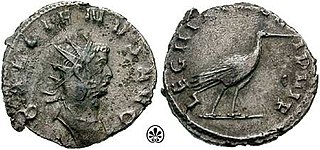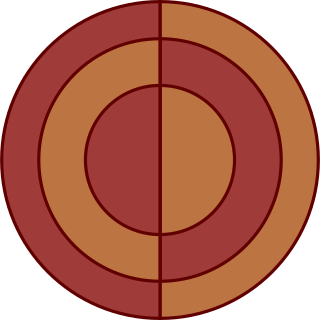
Legio VIII Augusta was one of the oldest legions of the Imperial Roman army.

Legio X Gemina, was a Roman legion, which was active during the late Roman Republic and later the Roman Empire as part of the Imperial Roman army. It was one of the four legions used by Julius Caesar in 58 BC, during the Roman invasion of Gaul. After being briefly disbanded, the legion was reconstituted by Augustus and fought on the side of the Second Triumvirate during the Liberators' Civil War and later on the side of Augustus during the War of Actium which ended the Crisis of the Roman Republic. The legion remained active for centuries, with surviving records of its continued existence in Vienna as late as the 5th century AD. The legion's symbol was a bull. Early on in its history, the legion was called X Equestris (mounted), because Caesar once used the legionaries as cavalry.

Legio XIII Gemina, in English the 13thTwin(s) Legion ; was a legion of the Imperial Roman army. It was one of Julius Caesar's key units in Gaul and in the civil war, and was the legion with which he crossed the Rubicon in January, perhaps on 10 January, in 49 BC. The legion appears to have still been in existence in the 5th century AD. Its symbol was the lion.

Legio III Italica was a legion of the Imperial Roman army founded in 165 AD by the emperor Marcus Aurelius for his campaign against the Marcomanni tribe. The cognomen Italica suggests that the legion's original recruits were drawn for the defence of Italy. The legion was still active in Raetia and other provinces in the early 5th century.

The Jovians and Herculians were the senior palatine imperial guard units under the rule of Roman Emperor Diocletian. They continued in existence thereafter as senior units in the field armies of the Western and Eastern Roman Empires.

Scythia Minor or Lesser Scythia was a Roman province in late antiquity, corresponding to the lands between the Danube and the Black Sea, today's Dobruja divided between Romania and Bulgaria. It was detached from Moesia Inferior by the Emperor Diocletian to form a separate province sometime between 286 and 293 AD. The capital of province was Tomis. The province ceased to exist around 679–681, when the region was overrun by the Bulgars, which the Emperor Constantine IV was forced to recognize in 681.

Dux Britanniarum was a military post in Roman Britain, probably created by Emperor Diocletian or Constantine I during the late third or early fourth century. The Dux (literally, " leader" was a senior officer in the late Roman army of the West in Britain. It is listed in the Notitia Dignitatum as being one of the three commands in Britain, along with the Comes Britanniarum and Count of the Saxon Shore.

Legio V Macedonica was a Roman legion. It was probably originally levied in 43 BC by consul Gaius Vibius Pansa Caetronianus and Gaius Julius Caesar Octavianus. It was based in the Balkan provinces of Macedonia, Moesia and Dacia. In the Notitia Dignitatum records from beginning of the fifth century, the legion was still stationed in Dacia, with detachments stationed in the east and Egypt.

The Legio I Maximiana was a comitatensis Roman legion, probably created by Emperor Diocletian in 296 or 297 AD. The legion was named after Maximianus, a colleague of Diocletian. The I Maximiana was formed together with II Flavia Constantia, to garrison the newly created province Thebaidos, in Aegyptus. As well as protect it from neighboring tribes. Since no Legio I Maximiana is listed as being stationed at Thebes in the Notitia Dignitatum, the designation is interpreted more broadly as of the Thebaid in general. The legion is also known as Maximiana Thebanorum or Thebaeorum. The cognomen Maximiana originated from Maximian, Diocletian's colleague.

Legio VI Herculia was a Roman legion levied by Diocletian in the end of the 3rd century, and was still in service at the beginning of the 5th century. The cognomen of the legion refers to Hercules, to whom Diocletian's colleague, Maximian, was devoted and identified.

Legio XV Apollinaris was a legion of the Imperial Roman army. It was recruited by Octavian in 41/40 BC. The emblem of this legion was probably a picture of Apollo, or of one of his holy animals.
Legio II Isaura was a pseudocomitatensis Roman legion, levied no later than under Diocletian, and possibly already present under Probus. As their name suggests, II Isaura and its twin legion III Isaura were guarding the Isauria territory at the time of the Notitia Dignitatum, to defend it from the incursions of the mountain peoples. It is possible that in the beginning they were supported by I Isaura Sagittaria. According to Ammianus Marcellinus, in 360, they were stationed in Bezabde with II Armeniaca, and II Parthica, when the king of Persia, Shapur II besieged and conquered the city, killing many of the inhabitants.
Legio I Iovia was a Roman legion, levied by Emperor Diocletian (284–305), possibly together with II Herculia, to guard the newly created province of Scythia Minor. The cognomen of this legion came from Diocletian's attribute Iovianus, "similar to Jupiter". It was based at Noviodunum ad Istrum. According to Notitia Dignitatum, at the beginning of the 5th century I Iovia was still in its camp on the Danube. The legion may have even survived the fall of Rome and continued to serve the Byzantine empire.
Legio II Herculia was a Roman legion, levied by Emperor Diocletian (284–305), possibly together with I Iovia, to guard the newly created province of Scythia Minor. It was stationed at Capidava. The cognomen of this legion came from Herculius, the attribute of Maximian meaning "similar to Hercules".

Dinogetia was an ancient Geto-Dacian settlement and later Roman fort located not far from the right (southern) bank of the Danube near the junction of the Siret River. The Dinogetia site is situated in Northern Dobruja, Romania, 8 km east of Galați and 2 km north of Garvăn, a village in Jijila commune.
Publius Aelius Aelianus was a senior officer in the Imperial Roman army in the mid-3rd century AD who rose from lowly origins to become the prefect of a legion under Emperor Gallienus. He was one of the earliest beneficiaries of Gallienus's policy that effectively excluded senators from army commands in favour of career-soldiers of equestrian rank. His later life is obscure.
The Legio IV Italica was a legion of the Imperial Roman army raised in AD 231 by emperor Alexander Severus. The legion remained in existence as late as AD 400.

Moesia Prima was a frontier province of the Late Roman Empire, situated in the central parts of present-day Serbia, along the south bank of the Danube River. Provincial capital was Viminacium, near modern Kostolac in Serbia).










